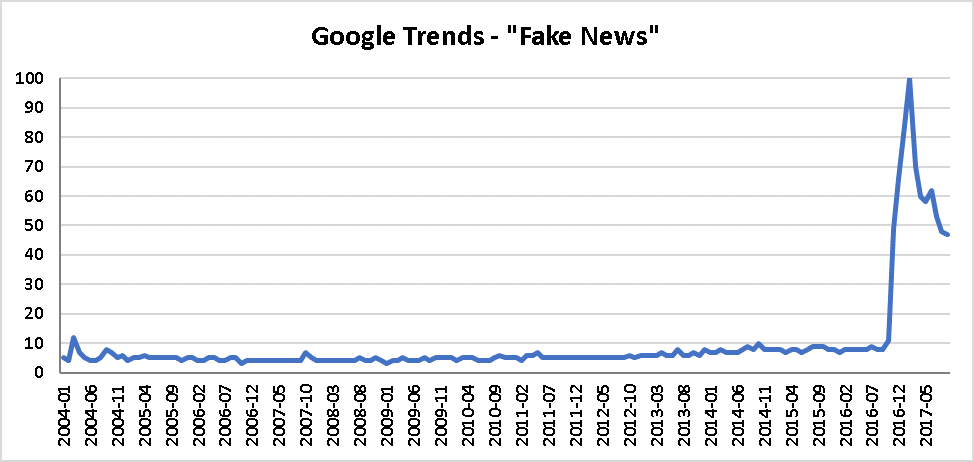How Does Fake News Impact Public Relations?
(Part 1 of 4)
“Your organization is terrible,” said then President-elect Donald Trump, as Jim Acosta struggled to keep his composure. “You are fake news”, Trump added.It seems with that statement, although we heard it well before then, that the mainstream media was set into a four-year war that is showing no sign of slowing down. What war might you ask? Essentially, this is a war between those who distrust the media versus the media itself.
Modern Day Fake News
The term “fake news” really wasn’t even a real phenomenon of sorts until then President-elect started to use it against the media during his bid for the general election. Google Trends really didn’t start picking up chatter on this topic until October 2016 (as the graph below indicates) and interest hit its peak when Trump attacked Jim Acosta during a press conference in January. Trump used the term on live television, as he had done before, but this time it seemed different. It seemed that this “fake news” trend wasn’t going away. Why is any of this relevant to public relations professionals? Good question. If our President is constantly attacking the mainstream media, won’t the public begin to distrust the media as well? The answer isn’t as clear cut as it seems, and over the next several blog posts we’ll explore what this “fake news” phenomenon means for our industry.
Why is any of this relevant to public relations professionals? Good question. If our President is constantly attacking the mainstream media, won’t the public begin to distrust the media as well? The answer isn’t as clear cut as it seems, and over the next several blog posts we’ll explore what this “fake news” phenomenon means for our industry.
The History of Fake News
 While the modern form of “fake news” hasn’t been around long, news that is fake has been around for a long time. Merriam-Webster, yes the dictionary, conducted some research on the topic of fake news and cited some interesting examples from the late 1800’s, including one example of the phrase being used in the literal sense:
While the modern form of “fake news” hasn’t been around long, news that is fake has been around for a long time. Merriam-Webster, yes the dictionary, conducted some research on the topic of fake news and cited some interesting examples from the late 1800’s, including one example of the phrase being used in the literal sense:
“Secretary Brunnell Declares Fake News About His People is Being Telegraphed Over the Country.—Cincinnati Commercial Tribune (Concinnati, OH), 7 Jun. 1890”
In present day, the phrase is used a little differently. All sides of the political spectrum are using this term and pushing it to the forefront, using it to describes many unique situations that the phrase wasn’t meant to describe. While it’s no secret that Trump loves to use the phrase, we are commonly seeing the phrase being used by “alt-right” groups and other fringe groups who are doing their best to tear down the media’s credibility – for whatever side they are fighting for. Some would argue that the phrase is a tool for the fringe groups to attack the media with. Simply put, the phrase is front of mind for everyone in the United States right now (unless you live under a rock).To put it in perspective a little more, I conducted a quick google search of the phrase to see how the media was discussing it this week. I uncovered more than 50 cases of the term “fake news” being used in headlines of stories that appeared on what we would classify at Universal as “Tier 1” media outlet (fancy term for national media outlets). Just look at these headlines from the last several days to see how we are utterly consumed by the phrase:
- “Facebook undermines its own effort to fight fake news” – Politico, 9/7/2018.
- “Rush Limbaugh’s dangerous suggestion that Hurricane Irma is fake news” – The Washington Post, 9/6/2017.
- “Why fake news spreads like wildfire on Facebook” – Chicago Tribune, 9/3/2017.
Here at Universal, we’ve seen the effects, too. We live, eat, sleep, and breath media coverage – so naturally, we’ve seen it and have absolutely heard of it. And of course, we’ve been following this trend since the beginning of the election when the phrase came to the forefront. We’ve helped clients find stories about their organization being related to fake news, we’ve helped measure the effect it has on them, and we’re constantly educating our clients on what the term means and how to identify fake news.In support of AMEC’s measurement month, we’ll be navigating through this fake news crisis that we seem to be in the middle of. The series of blogs will discuss:
- The public view of fake news and how trust is being eroded between public/media
- How our clients are viewing fake news and what questions they are asking us
- And how your organization can defend itself against fake news
 Be sure to give me a follow at @AustinOmaha and discuss this topic with me. I’d love to chat about your thoughts, opinions, and insight into this issue as it affects all of us.
Be sure to give me a follow at @AustinOmaha and discuss this topic with me. I’d love to chat about your thoughts, opinions, and insight into this issue as it affects all of us.

